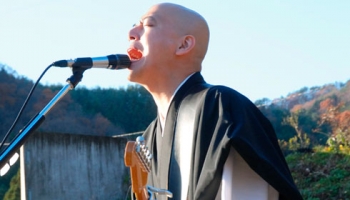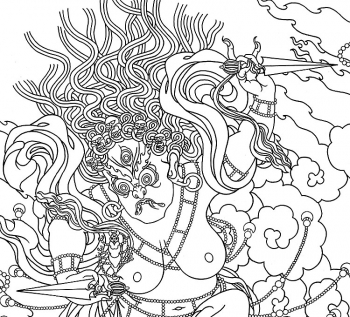 A screenshot from the Japanese film Abraxas.
A screenshot from the Japanese film Abraxas. Demonic wisdom that transmutes into wisdom and enlightenment.
Demonic wisdom that transmutes into wisdom and enlightenment.There are many tales within Buddhist literature about people who go against social norms, do strange things, disobey authority and act quite strangely! Often these characters illustrate the benefits of detaching from the rules and regulations of society and symbolise the freedom an enlightened mind has from social conventions and norms. The idea of “going against the grain” as a means of detaching from the world is a prominent theme of Tantric Buddhism and is also reflected in the Buddhist narrative literatures of East Asia.
In India and Tibet, this strand of teaching led to the existence of many wandering ascetics called “siddhas” who practiced Buddhism in an unstructured and socially transgressive manner. These practitioners were recognised by their matted hair and strange appearance. They shunned organisational control and lived the life of an outsider. In many of the tales of the siddhas, a common element of the narrative is that they were ridiculed as “crazy” and persecuted by society. They were considered to be socially unacceptable and beyond reproach. However, these stories of the siddhas often end with a realisation by those who ridiculed them that these individuals were actually enlightened and often incarnations of various bodhisattvas. Sometimes the siddhas may reveal their true spiritual identity in their lifetime but more commonly their spiritual prowess is only recognised after they have died, particularly when certain miracles have indicated their true identities.
These tales have a variety of purposes in illustrating this Buddhist path of “crazy wisdom”. The common contrast between a siddha‘s spiritual and social identity, being both enlightened and exiled, provides a reminder about the universal potential for enlightenment, often termed “Buddha nature”. It is common to look for “religion” or “spirituality” only in certain socially designated places – an enlightened individual is only to be found in the temple or meditation centre and certainly not in a supermarket or homeless shelter, for instance. The symbol of the enlightened madman teachers us that spiritual perfection can be found in any area of society and at any time. This combination of the most venerated state of human existence, “enlightenment”, with one of the most peripheral and persecuted sections of society, “the mad”, constantly invites a reinterpretation of the nature and location of dharma and nirvana.
The siddha tradition, in bringing Buddhism to the periphery of society, also provides a space for those who have been disenfranchised and abandoned by the mainstream. Religion is often seen as occupying the centre-ground of society. As a result, any charity work is considered to be “outreach”, a brief extension into unfamiliar and hostile areas. In contrast, this anarchic form of Buddhism seeks to subvert the value of centres and constantly places itself on the outside. It does not seek to form a temporary presence with the disenfranchised, like many forms of charity entail, as its foundation and essence is with the underclass of society and always has been. Therefore, this subversive form of Buddhism can provide a distinct and empowering form of service and outlet to those in need.
The tantric ideal of “crazy wisdom” is certainly a powerful tool for those who are stuck in harsh environments. For those who cannot avoid sensual experience, who do not have the opportunity to go on retreat to quiet and safe places, the central Tantric idea that we can use our sensual experiences to further our spiritual progress is a liberating notion. For the siddha, truth does not lie in experience itself but in one’s relationship with experience. It doesn’t matter if our experiences are pleasurable or painful, so long as our relationship to them is one of detachment, letting go and freedom. If we are rejected, ostracised, pushed to the side and ignored by society, it is a comfort to know that this is the ground for nirvana, if only we can alter our approach to reality. This is not to say that there will be no suffering, that there will be no pleasure or pain. Everything will be as it was. However, there will be nobody to suffer, nobody to feel pleasure and nobody to feel that pain.
















